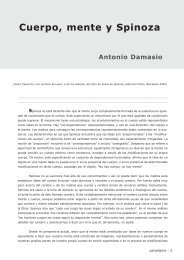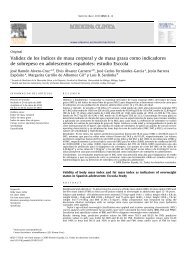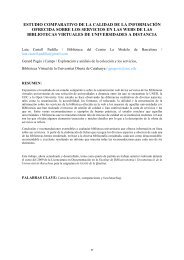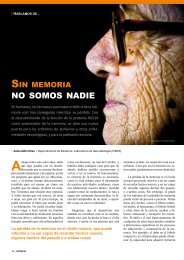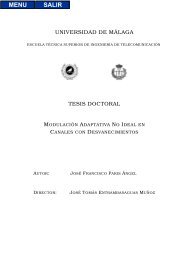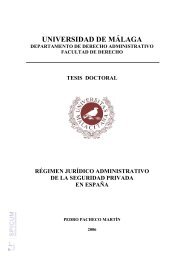Estereotipos negativos hacia la vejez y su relación con variables ...
Estereotipos negativos hacia la vejez y su relación con variables ...
Estereotipos negativos hacia la vejez y su relación con variables ...
Create successful ePaper yourself
Turn your PDF publications into a flip-book with our unique Google optimized e-Paper software.
Referencias<br />
Steele, C. (1997). A threat in the air: How stereotype threat and women´s math performance.<br />
American Psychologist, 52, 4-28.<br />
Stephan, W. G. y Rosenfiled, D. (1978). Effects of desegregation on ratial attitudes. Journal of<br />
Personality and Social Psychology, 36, 795-804.<br />
Steven-Long, J. y Commons, M. (1992). Adult life: Developmental Processes. California: Mayfield<br />
Publishing Company.<br />
Stevens, J. y Crouch, M. (1992). Working with the elderly: Do nurses care for it? Australian Journal<br />
of Advanced Nursing, 9(3), 12-17.<br />
Stevens, E. S. (1993). Making sense of usefulness: An avenue toward satisfaction in <strong>la</strong>ter life.<br />
International journal of Aging and Human Development, 37(4), 313-325.<br />
Steverink, N., Westerhof, G., Bode, C. y Dittmann-Kohli, F. (2001). The Personal Experience of<br />
Aging, Individual Resources, and Subjective Well-Being. Journal of Gerontology, 56(6), 364-<br />
373.<br />
Stewart, A. L. y King, A. C. (1994). Conceptualizing and mea<strong>su</strong>ring quality of life in elder<br />
popu<strong>la</strong>tions. En R. P. Abeles, H. C. Gift and M. G. Ory (Eds). Aging and quality of life. New<br />
York: Springer Publishing Company.<br />
Stewart, A. L. y King, A. C. (1991). Evaluating the efficacy of physical activity for influencing<br />
quality-of-life outcomes in older adults. Annals of Behavioral Medicine, 13(3), 108-116.<br />
Stewart, A. L., Mills, K., Sepsis, P., King, A., McLel<strong>la</strong>n, B., Roitz, K. y Ritter, P. (1997). Evaluation<br />
of CHAMPS, a physical activity promotion program for older adults. Annals of Behavioral<br />
Medicine, 19(4), 353-361.<br />
Stock, W., Okum, M. y Benito, J. (1994). Subjective well-being mea<strong>su</strong>res: Reliability and validity<br />
among Spanish elders. International Journal of Aging and Human Development, 38(3), 221-<br />
235.<br />
Stuart-Hamilton, I. (2002). Psicología del envejecimiento. Madrid: Morata.<br />
Subitars, J. (1992). La <strong>vejez</strong> como oportunidad. Un estudio sobre <strong>la</strong>s políticas de tiempo libre<br />
dirigidas a <strong>la</strong> gente mayor. Barcelona: Editorial Universidad Autónoma de Barcelona.<br />
Suganuma, M. (1997). Self disclo<strong>su</strong>re and self-esteem in old age. Japanese Journal of Educational<br />
Psychology, 45(4), 12-21.<br />
Sweeny, J. y Creer T. (1995). Health-re<strong>la</strong>ted quality-of-life assessment in medical care. Disease-a-<br />
Month, 61(1), 3-71.<br />
Tabachnick, F. G. y Fidell, L. S. 1989). Unisn multivariate statistiscs (2nd. Ed.). New York:<br />
Herpercollins Publishers, Inc.<br />
Tackett, R. A. (2001). Corre<strong>la</strong>tes of life satisfaction after retirement. Dissertation- Abstracts-<br />
International:- Section –B:- The Sciencies and Engineering, 62(3-B), 1622.<br />
Tajfel, H. (1981). Human groups and social categories. Cambridge: University Press.<br />
254




